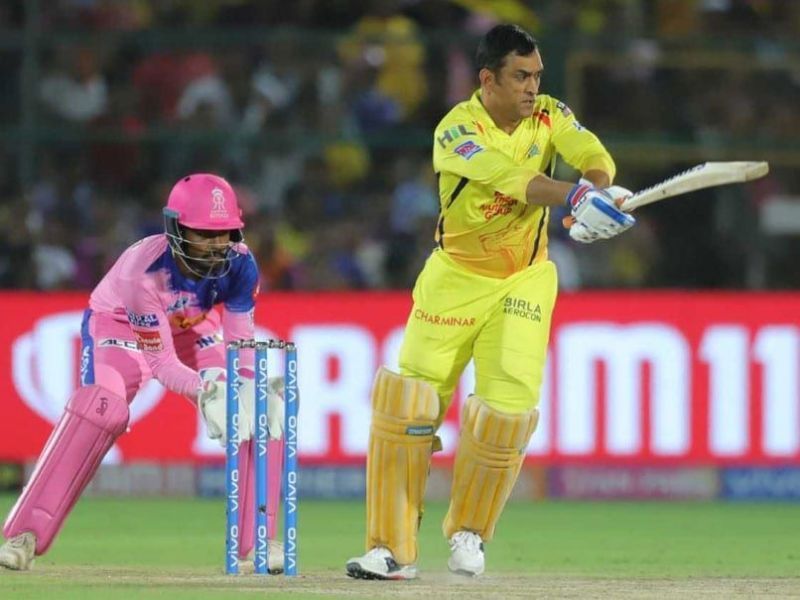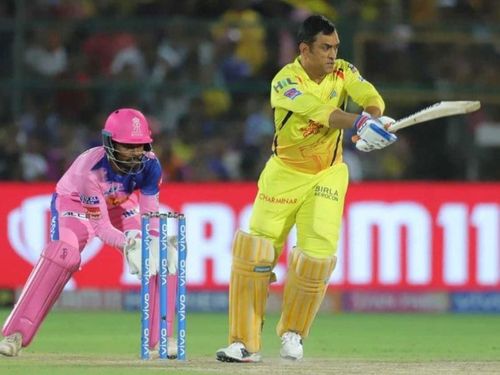
Why did MS Dhoni skittle himself down the order against Rajasthan Royals?

At the very outset, it is pertinent to mention that CSK did not lose their second match in IPL 2020 against Rajasthan Royals because of MS Dhoni. We remember what happens at the back end of an innings because it is succeeded by none else, and its possibility of overlap with adjoining memories is reduced.
Evaluating T20 from diminutive points is necessary because the final over describes only 2.5% of the entire story. When you do that, you are left with myopic conclusions like Jonny Bairstow losing SRH their last game.
Across the length and breadth of his career, MS Dhoni has taken two approaches to a run-chase (to which we shall come soon). When faced with the ability to take neither, he plays an awkward, dependent waiting game in which a positive result is only a bonus. Against Rajasthan Royals, he was in such a spot.
Faf du Plessis was struggling. He sprauchled his way to 2 off 3, 4 off 5 and 17 off 18 at various points in the game when in a selective and neurotic bid to increase the run-rate, wickets were crumbling.
He frisked down the pitch and carved the ball off the inside half of the bat. He galumphed to the legside and hoicked Jaydev Unadkat no paster than the 30-yard circle. When a free-hit was doled out, he whumped the ball into the legside for a measly one. Over the years, this has been Chennai's assigned role for Du Plessis as his strengths are intended to be utilised in a certain way.
It was precisely the reason why the South African played as few as six games in 2018 when CSK's home surface was the batting Shangri-La of Pune, the large majority of them being away fixtures. This is where South Africa also used Du Plessis in the 2014 World Cup when AB de Villiers was dribbled down to number five to make room for the anchor.
Had it not been for the false reassurance offered by his previous innings on a pitch that suited his style of game and the fact that Ambati Rayudu wasn't fit, there was a teensy, weensy possibility that Du Plessis might not even have played. There is a solid argument that he must not have against the Royals. There is an argument for Rayudu to have opened alongside Watson. But— the uncontrollables!
MS Dhoni's approach in successful chases have had a common pattern
Now, CSK are built around MS Dhoni (by choice). They so closely follow his approach to an innings: Each of Dhoni's successful chases (or attempts) have come when there have been either batsmen at the other end who are wielding the long handle, or as in more recent times, when the opposition is covering a gaping hole in their bowling unit.
To a degree, every batsman chalked up to this role approached a chase similarly, as this article validates. We talk them up and marry with incomparable glory because through a pattern of minimal risks, they are at the finishing line and our psyches are wired to retain the finales.
A beleaguered Faf du Plessis and MS Dhoni batting together with the asking rate ticking 13 would have been a recipe for disaster.
Curran's promotion, unlike what many are likely to think, was a major success for CSK. With four overs of the leg-spinners left and dew unyoked, it was essential that the slow bowlers were punctured sheepishly, treading on MS Dhoni's primary action plan of setting up the game for him to anchor.
However, by the time Jadhav strutted out to the crease, this plan had faltered. CSK had shifted goals from attacking the spinners to taking the game deep and evaluating from a closer standpoint, like MS Dhoni often does.
A set MS Dhoni averaged 29 and struck at 126 against the likes of Gopal and Tewatia. A Dhoni with a year-long experience of chopping vegetables?
When he strolled out to the middle with an over of Tewatia still left, victory was likely not on his mind: it was only a bonus like he treated a KXIP game in 2018 and an ODI in England in the same year. If it was, by extension of the same logic that promoted Curran to number four, Jadeja should have been the man for a one-over wrangle.
When the resources are not by his side, MS Dhoni frequently treads down this thought chain: in the early parts of the 2018 edition of the IPL, he called himself a 'practical man' after a similar game.
In Jofra Archer, Jaydev Unadkat and Tom Curran, he did not see an opening, and Du Plessis' sudden sprite of hitting was hardly enough to compensate for MS Dhoni playing himself in against the spike in run-rate. MS Dhoni probably realised that and treated the win as a bonus, like he rightly should, in a tournament that evaluates the margins of defeat.
Check the new IPL 2020 schedule here.
Ultimately, it was the idea of the anchor in T20 that was exposed once again: Faf du Plessis' fracas generated the need for thwacking from the other side, but MS Dhoni was clearly not the best-equipped to do that.
When he walked out, the match was as well as over in MS Dhoni's eyes; the final attempt was a counter-attacking stabilising act from Jadhav that did not go as well as planned.
The shellacking loss of MS Dhoni's wicket while looking for an improbable win was less beneficial than the possible damage-control to CSK's NRR as Faf du Plessis explored the probabilities of victory. In thinking so, MS Dhoni was right. In his own words, he is a 'practical man'.
These are patterns of his brain we should be used to after all these years of seeing, loving and hating him. Yet the images that trend on Twitter are our bile, the voices that play him up to a non-existent limited-overs role are our supply.
It is a shame because these things ought to be thought of in a certain way, yet external influences render us incapable of doing so. In other words, thank you, the Gavaskars of this world. For a man who saves such precious little of himself for the world, MS Dhoni did offer a clue about his mind when he said:
"I haven't batted for a long time, and a 14-day quarantine doesn't help."
Is MS Dhoni really all that inscrutable? Perhaps, the answer is no, but we just like to make him out to be.